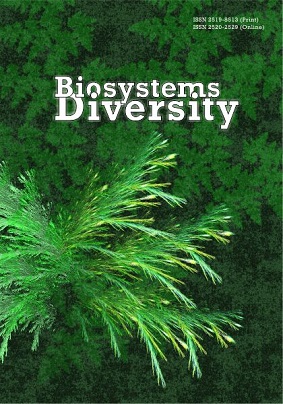Влияние технологии возделывания многолетних мятликовых трав на их транспирацию в условиях заливных лугов
Influence of technologies of cultivation on the transpiration of periennial blue grass herbs grown in water meadows
Author(s): A. L. Silayev, E. V. Smolsky, N. M. Belous, S. M. PakshinaSubject(s): Human Ecology, Environmental interactions
Published by: Дніпропетровський національний університет імені Олеся Гончара
Keywords: alluvial soil; perennial herbs; handling of the soil; photosynthetically active radiation; radiation balance; transpiration;
Summary/Abstract: This article discusses the process of transpiration in perennial herb crops in the southwest of Bryansk region (Russia) under different technologies of cultivation, using superficial and radical improvement of natural fodder conditions. Experimental field surveys were conducted on the flood plain of the river Input in 2009–2014. These years were characterized by different phytoclimatic conditions. The amounts of daily values of radiation balance for the period of vegetation in 2010, 2012, 2013, 2014 constituted respectively 1127, 1126, 1181, 1157 MDzh/m2 whereas during 2009 and 2011 respectively they came to 963 and 915 MDzh/m2. The maximum daily values for photosynthetically active radiation (PAR) were observed in 2012 and 2013 and constituted respectively 764 and 710 MDzh/m2, the minimum – in 2009 and 2011 – constituted respectively 635 and 592 MDzh/m2. During the vegetation period from the first hay crop to the second higher values of radiation balance and PAR were observed than during the period up to the first hay crop. Despite differences in the productivity between different variants of the cultures, a directly proportional linear dependence between productivity and transpiration with a high coefficient of correlation was obtained for every year of the research and stage of the hay crop. The transpiration coefficient for bluegrass herbs which are grown in river flood plains is established for the first time. The transpiration coefficient doesn’t depend on the type of dose and ratio between different fertilizers, nor on the method of preparing the soil. The transpiration coefficient of crops of bluegrass herbs doesn’t depend on doses and a type of the introduced fertilizers, the method of handling of the soil, and for the first and second hay crops respectively constituted 469 and 486 per dry weight. The increase in transpiration consumption of moisture in dry weight formation during the period from the first hay crop to the second was caused by decrease in bioavailability of moisture during this period. We established that the crops of bluegrass herbs cultivated on alluvial sandy soil without use of mineral fertilizers don’t use the moisture which is accumulated during the autumn and winter and spring period, and the crops of bluegrass herbs cultivated using mineral fertilizers lack moisture during the vegetation period from first to the second hay crop only in drought years. We have experimentally proved that mineral fertilizers raise the relative transpiration and bioavailability of soil moisture to plants. It is suggested that the soluble salts which are a component of fertilizers increase osmotic pressure in the vascular system of plants. It was proved that preseeding working of the soil with a turnover of the layer at a depth of 20 cm increases bioavailability of soil moisture and absorption of solar radiation during the vegetation period in drought years.
Journal: Biosystems Diversity
- Issue Year: 25/2017
- Issue No: 1
- Page Range: 9-15
- Page Count: 7
- Language: Russian

